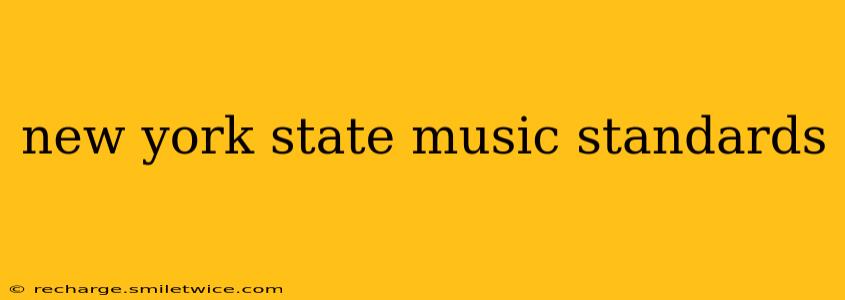New York State has established comprehensive music standards to ensure students develop a deep appreciation and understanding of music. These standards, designed to be implemented across various grade levels, focus on developing musical skills, knowledge, and creativity. This guide provides a detailed overview of these standards, addressing common questions and offering insights into their implementation.
What are the New York State Music Learning Standards?
The New York State Music Learning Standards are a set of benchmarks outlining what students should know and be able to do in music at each grade level. These standards aren't just about learning to play an instrument; they encompass a broad range of musical experiences, including:
- Creating: Composing, improvising, arranging music.
- Performing: Playing instruments, singing, dancing.
- Responding: Critically analyzing music, expressing personal responses to music.
- Connecting: Understanding music's historical, cultural, and social contexts.
The standards are designed to be progressively challenging, building upon foundational skills and knowledge as students advance through the grades. They emphasize both musical proficiency and a deeper understanding of music's role in society and culture.
What are the different strands within the New York State Music Standards?
The New York State Music Standards are organized into four interconnected strands:
-
Creating: This strand focuses on the student's ability to compose, improvise, and arrange music. Students learn to generate their own musical ideas, experiment with different musical elements, and develop their own unique musical voice.
-
Performing: This strand emphasizes the student's ability to execute musical works effectively. This includes playing instruments, singing, and movement, all with proper technique and expression.
-
Responding: This strand is all about critical listening and analysis. Students learn to identify musical elements, interpret musical meaning, and express their personal responses to music.
-
Connecting: This strand explores the broader context of music. Students learn about the history, culture, and social significance of various musical styles and traditions.
How are the New York State Music Standards implemented in schools?
The implementation of the New York State Music Standards varies across districts and schools. However, the standards serve as a framework for curriculum development, instruction, and assessment. Teachers use a variety of methods to teach these standards, including:
- Direct instruction: Lessons focusing on specific musical concepts and skills.
- Experiential learning: Hands-on activities, such as composing, performing, and listening to music.
- Collaborative work: Group projects, ensembles, and performances.
- Assessment: Various methods are used to gauge student understanding, including performances, written tests, and portfolios.
What resources are available for teachers to support the implementation of the New York State Music Standards?
The New York State Education Department offers several resources to support teachers in implementing the music standards. These resources may include curriculum guides, sample lesson plans, and professional development opportunities. Additionally, many organizations and websites provide supplementary materials and support for music education. Looking into your local school district’s resources is crucial for accessing these materials.
How are students assessed on the New York State Music Standards?
Assessment methods are diverse and tailored to the specific grade level and the standards being assessed. Performance-based assessments are often used, evaluating a student’s ability to perform musically. This might involve playing an instrument, singing, or demonstrating knowledge of musical theory through composition or analysis. Written assessments, projects, and portfolios are also used to measure students' understanding of musical concepts and their ability to apply them.
Are there different standards for different grade levels?
Yes, the New York State Music Standards are designed to be grade-specific. The expectations for a kindergarten student will be fundamentally different from those of a high school student. The standards build progressively, introducing new concepts and increasing the complexity of tasks as students advance through the grades. This ensures that students develop a strong foundation in music and progressively increase their knowledge and skills.
This comprehensive guide provides a foundational understanding of the New York State Music Standards. Remember to consult your local school district and the New York State Education Department for the most up-to-date information and resources. The standards aim to cultivate a love for music and foster musical growth in all students.
